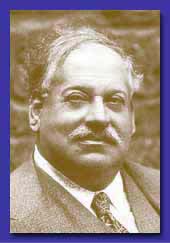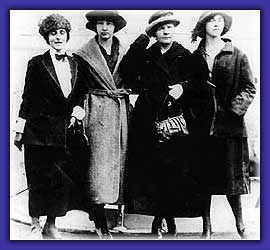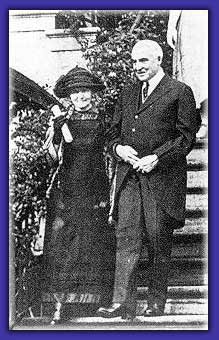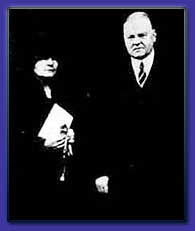
|
| French philanthropist Henri
de Rothschild was enthralled by science and funded many research
efforts. Rothschild grants helped Curie to support her scientific
staff--including the man who would become Irène's husband and
collaborator. |
|

 The Marie Curie Radium Campaign
The Marie Curie Radium Campaign
 HE
NEVER OVERCAME STAGE FRIGHT
as a professor, though she taught for nearly 30 years. Yet in order
to turn the Radium Institute into a world-class institution, Curie
shamelessly sought out assistance, just as she had done during the
war years to create the radiological service. Throughout her career
Curie had benefitted from the subsidies of wealthy French benefactors.
Now, thanks to the interest of an American woman, U.S. citizens
also became involved in filling the needs of the Radium Institute. HE
NEVER OVERCAME STAGE FRIGHT
as a professor, though she taught for nearly 30 years. Yet in order
to turn the Radium Institute into a world-class institution, Curie
shamelessly sought out assistance, just as she had done during the
war years to create the radiological service. Throughout her career
Curie had benefitted from the subsidies of wealthy French benefactors.
Now, thanks to the interest of an American woman, U.S. citizens
also became involved in filling the needs of the Radium Institute.
“[Curie],
who handles daily a particle of radium more dangerous than lightning,
was afraid when confronted by the necessity of appearing before
the public.”--Stéphane Lauzanne, editor-in-chief
of Le Matin
|
Despite
her distrust of journalists, in May 1920 Curie agreed to give an interview
to Mrs. William Brown Meloney, editor of an American women's magazine.
In the interview Curie emphasized the needs of her institution, where
research was just resuming following the devastating war.
Thanks to her alliance with industry, few labs in the world if any were better equipped with radium
than Curie's. But Curie succeeded in shocking Meloney by emphasizing the fact that
research and therapy centers in the United States together had about
50 times as much radium as the single gram she--the scientist who
had discovered the element--had in her laboratory. When Meloney learned
that Curie's most fervent wish was for a second gram for her laboratory,
the editor organized a “Marie Curie Radium Campaign.” |
 |
| Meloney, Irène, Marie and
Eve shortly after their arrival in the United States, where
the press dubbed Eve “the girl with the radium eyes.” |
|
|
Led by a committee
of wealthy American women and distinguished American scientists,
the campaign succeeded by soliciting contributions in the United
States. Meloney also arranged for Curie to write an autobiographical
work for an American publisher. The book would provide royalty income
over the years. Equally important, it would capture in simple and
moving prose the romantic and heroic image
of science that was so helpful for public support and fund-raising.
|
 |
| The high point of Curie's 1921 tour of the
United States was the White House presentation by President
Warren G. Harding, where she wore the same black dress she had
worn to both Nobel ceremonies. Thanks to the Marie Curie Radium
Campaign, she returned to Paris with ores, costly apparatus,
and cash for her institute, in addition to the gram of radium.
(Photo ACJC) |
|
 HE
LANGEVIN AFFAIR
could not be mentioned in print. On this condition Curie agreed
to travel to the United States to drum up support for her institute.
Meloney wrested from editors across the country a promise to suppress
the old story. When word got out that the President of the United
States himself would present Curie with the gift of radium, French
officials looked for a way to make up for past oversights. Curie
refused the Legion of Honor award (as Pierre had refused it nearly
two decades earlier). But she agreed to attend a benefit for the
Radium Institute at the Paris Opera shortly before setting sail. HE
LANGEVIN AFFAIR
could not be mentioned in print. On this condition Curie agreed
to travel to the United States to drum up support for her institute.
Meloney wrested from editors across the country a promise to suppress
the old story. When word got out that the President of the United
States himself would present Curie with the gift of radium, French
officials looked for a way to make up for past oversights. Curie
refused the Legion of Honor award (as Pierre had refused it nearly
two decades earlier). But she agreed to attend a benefit for the
Radium Institute at the Paris Opera shortly before setting sail.
“I
pray to thank the Minister, and to inform him that I do not in the
least feel the need of a decoration, but that I do feel the greatest
need for a laboratory.”
--Pierre Curie refusing the Legion of Honor, 1903
|
|
Her right hand was
in a sling before she had been in the United States many days. So
many people wanted to shake hands with the woman who had given humanity
the gift of radium. Curie was grateful that her daughters were willing
to stand in for her when she felt she could not bear another public
function. Irène, for example, accepted some of the many honorary
degrees granted to her mother by universities and colleges.
In 1920 Curie and a
number of her colleagues created the Curie Foundation, whose mission
was to provide both the scientific and the medical divisions of the
Radium Institute with adequate resources. Over the next two decades
the Curie Foundation became a major international force in the treatment
of cancer. |
 |
| Curie with President Hoover in 1929, when
she made a second U.S. tour sponsored by Meloney. This time
she succeeded in equipping the Warsaw Radium Institute, founded
in 1925 with her sister Bronya as director.
|
|
|
 AMPAIGNS
TO RAISE MONEY
from governments as well as from individuals, were launched throughout
the 1920s in many countries including France itself. Marie's scientist
friends were especially active. Insisting that the quickest way
to a progressive future was to foster research, they formed partnerships
with liberal and socialist politicians, and they supported political
parties that would increase government funding. Despite her shyness
Marie helped in the work of lobbying, going with her friends from
office to office. She could argue fervently, but her appearance
alone was the strongest argument. A frail and aging woman dressed
in black, already a legendary figure, she had--as one observer put
it--the appearance and moral force of a Buddhist monk. AMPAIGNS
TO RAISE MONEY
from governments as well as from individuals, were launched throughout
the 1920s in many countries including France itself. Marie's scientist
friends were especially active. Insisting that the quickest way
to a progressive future was to foster research, they formed partnerships
with liberal and socialist politicians, and they supported political
parties that would increase government funding. Despite her shyness
Marie helped in the work of lobbying, going with her friends from
office to office. She could argue fervently, but her appearance
alone was the strongest argument. A frail and aging woman dressed
in black, already a legendary figure, she had--as one observer put
it--the appearance and moral force of a Buddhist monk.
� 2000 -
American Institute of Physics
|
|

